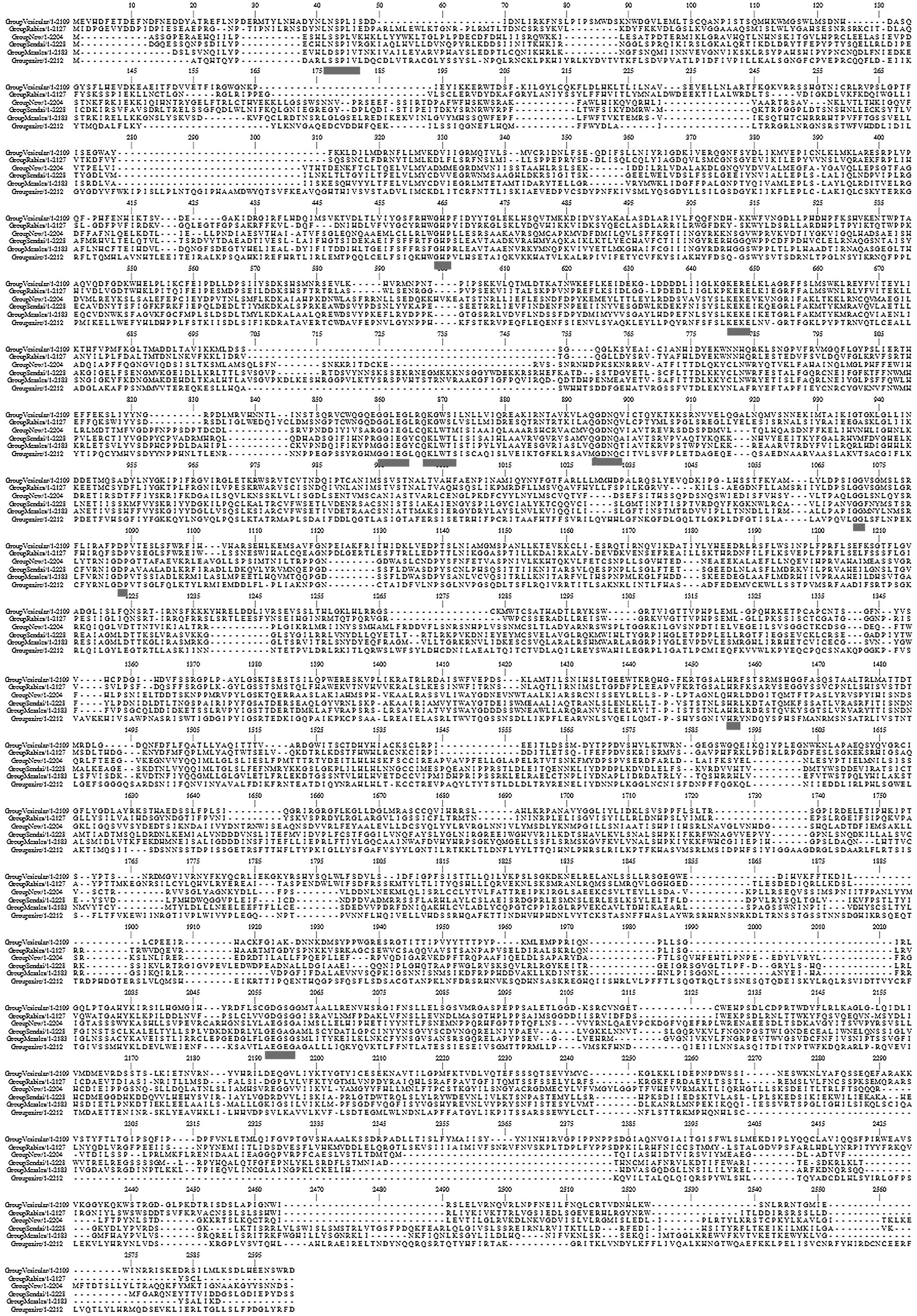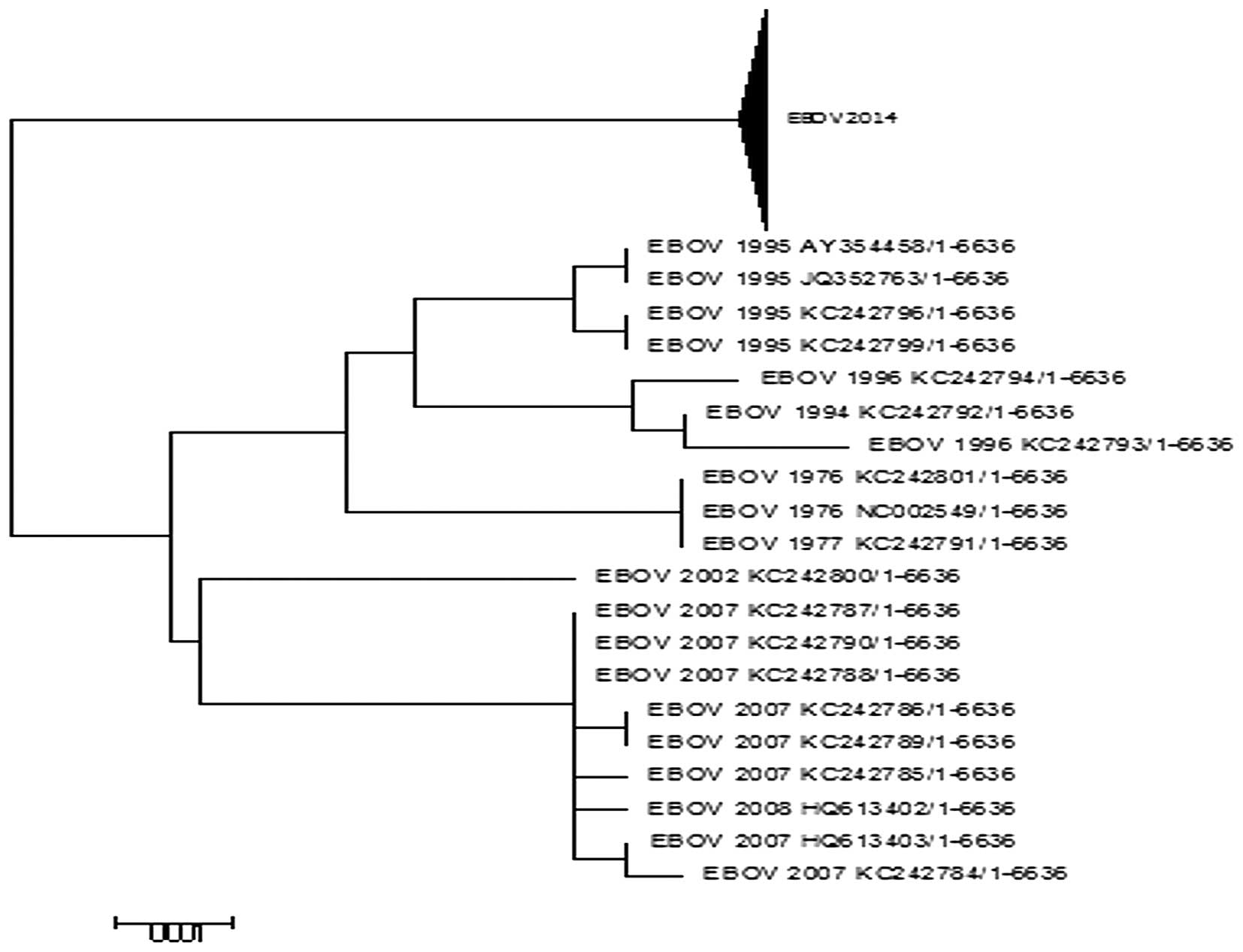|
1
|
Sanchez A, Geisbert TW and Feldmann H:
Filoviridae: Marburg and ebola viruses. Fields Virology. Knipe DM
and Howley PM: Lippincott Williams and Wilkins; Philadelphia, PA:
pp. 1409–1448. 2007
|
|
2
|
Kuhn JH, Becker S, Ebihara H, Geisbert TW,
Johnson KM, Kawaoka Y, Lipkin WI, Negredo AI, Netesov SV, Nichol
ST, et al: Proposal for a revised taxonomy of the family
Filoviridae: Classification, names of taxa and viruses and virus
abbreviations. Arch Virol. 155:2083–2103. 2010. View Article : Google Scholar : PubMed/NCBI
|
|
3
|
Sanchez A, Kiley MP, Holloway BP and
Auperin DD: Sequence analysis of the Ebola virus genome:
Organization, genetic elements, and comparison with the genome of
Marburg virus. Virus Res. 29:215–240. 1993. View Article : Google Scholar : PubMed/NCBI
|
|
4
|
Boehmann Y, Enterlein S, Randolf A and
Mühlberger E: A reconstituted replication and transcription system
for Ebola virus Reston and comparison with Ebola virus Zaire.
Virology. 332:406–417. 2005. View Article : Google Scholar : PubMed/NCBI
|
|
5
|
Waheed Y: Ebola in West Africa: An
international medical emergency. Asian Pac J Trop Biomed.
4:673–674. 2014. View Article : Google Scholar
|
|
6
|
Waheed Y, Bhatti A and Ashraf M: RNA
dependent RNA polymerase of HCV: A potential target for the
development of antiviral drugs. Infect Genet Evol. 14:247–257.
2013. View Article : Google Scholar : PubMed/NCBI
|
|
7
|
Waheed Y, Saeed U, Anjum S, Afzal MS and
Ashraf M: Development of global consensus sequence and analysis of
highly conserved domains of the HCV NS5B prote in. Hepat Mon.
12:e61422012.PubMed/NCBI
|
|
8
|
Gire SK, Goba A, Andersen KG, Sealfon RS,
Park DJ, Kanneh L, Jalloh S, Momoh M, Fullah M, Dudas G, et al:
Genomic surveillance elucidates Ebola virus origin and transmission
during the 2014 outbreak. Science. 345:1369–1372. 2014. View Article : Google Scholar : PubMed/NCBI
|
|
9
|
Poch O, Blumberg BM, Bougueleret L and
Tordo N: Sequence comparison of five polymerases (L proteins) of
unsegmented negative-strand RNA viruses: Theoretical assignment of
functional domains. J Gen Virol. 71:1153–1162. 1990. View Article : Google Scholar : PubMed/NCBI
|
|
10
|
Clamp M, Cuff J, Searle SM and Barton GJ:
The Jalview Java alignment editor. Bioinformatics. 20:426–427.
2004. View Article : Google Scholar : PubMed/NCBI
|
|
11
|
Katoh K and Standley DM: Improvements in
performance and usability. Mol Biol Evol. 30:772–780. 2013.
View Article : Google Scholar : PubMed/NCBI
|
|
12
|
Nuin PA, Wang Z and Tillier ER: The
accuracy of several multiple sequence alignment programs for
proteins. BMC bioinformatics. 7:4712006. View Article : Google Scholar : PubMed/NCBI
|
|
13
|
Tamura K, Stecher G, Peterson D, Filipski
A and Kumar S: MEGA6: Molecular evolutionary genetics analysis
version 6.0. Mol Biol Evol. 30:2725–2729. 2013. View Article : Google Scholar : PubMed/NCBI
|
|
14
|
Saitou N and Nei M: A new method for
reconstructing phylogenetic trees. Mol Biol Evol. 4:406–425.
1987.PubMed/NCBI
|
|
15
|
Ng PC and Henikoff S: Predicting
deleterious amino acid substitutions. Genome res. 11:863–874. 2001.
View Article : Google Scholar : PubMed/NCBI
|
|
16
|
Marston DA, McElhinney LM, Johnson N,
Müller T, Conzelmann KK, Tordo N and Fooks AR: Comparative analysis
of the full genome sequence of European bat lyssavirus type 1 and
type 2 with other lyssaviruses and evidence for a conserved
transcription termination and poly-adenylation motif in the G-L 3′
non-translated region. J Gen Virol. 88:1302–1314. 2007. View Article : Google Scholar : PubMed/NCBI
|
|
17
|
Volchkov VE, Volchkova VA, Chepurnov AA,
Blinov VM, Dolnik O, Netesov SV and Feldmann H: Characterization of
the L gene and 5′ trailer region of Ebola virus. J Gen Virol.
80:355–362. 1999. View Article : Google Scholar
|
|
18
|
Schnell MJ and Conzelmann KK: Polymerase
activity of in vitro mutated rabies virus L protein. Virology.
214:522–530. 1995. View Article : Google Scholar : PubMed/NCBI
|
|
19
|
Blumberg BM, Crowley JC, Silverman JI,
Menonna J, Cook SD and Dowling PC: Measles virus L protein
evidences elements of ancestral RNA polymerase. Virology.
164:487–497. 1998. View Article : Google Scholar
|
|
20
|
Ogino T and Banerjee AK: The HR motif in
the RNA-dependent RNA polymerase L protein of Chandipura virus is
required for unconventional mRNA-capping activity. J Gen Virol.
91:1311–1314. 2010. View Article : Google Scholar : PubMed/NCBI
|
|
21
|
Ferron F, Longhi S, Henrissat B and Canard
B: Viral RNA-polymerases-a predicted 2′-O-ribose methyltransferase
domain shared by all Mononegavirales. Trends Biochem Sci.
27:222–224. 2002. View Article : Google Scholar : PubMed/NCBI
|
|
22
|
Grard G, Biek R, Tamfum JJ, Fair J, Wolfe
N, Formenty P, Paweska J and Leroy E: Emergence of divergent Zaire
Ebola virus strains in democratic republic of the Congo in 2007 and
2008. J Infect Dis. 204(Suppl 3): S776–S784. 2011. View Article : Google Scholar : PubMed/NCBI
|
|
23
|
Trunschke M, Conrad D, Enterlein S,
Olejnik J, Brauburger K and Mühlberger E: The L-VP35 and L-L
interaction domains reside in the amino terminus of the Ebola virus
L protein and are potential targets for antivirals. Virology.
441:135–145. 2013. View Article : Google Scholar : PubMed/NCBI
|
|
24
|
Chandrika R, Horikami SM, Smallwood S and
Moyer SA: Mutations in conserved domain I of the Sendai virus L
polymerase protein uncouple transcription and replication.
Virology. 213:352–363. 1995. View Article : Google Scholar : PubMed/NCBI
|
|
25
|
Feller JA, Smallwood S, Horikami SM and
Moyer SA: Mutations in conserved domains IV and VI of the large (L)
subunit of the Sendai virus RNA polymerase give a spectrum of
defective RNA synthesis phenotypes. Virology. 269:426–439. 2000.
View Article : Google Scholar
|
















